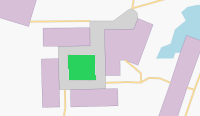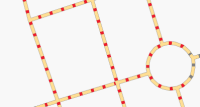Talk:Kosmos/FAQ
Jump to navigation
Jump to search
Q: Can I give also a color to dots of a line ?
- Could you give me a visual example of this?
- This is currently not possible due to the way the line is drawn in Kosmos. First a thicker way is drawn using the border color, then the thinner line is drawn over it - in your case using a dotted dash, that's why the border color is the same as the "points" color - these are just the leftovers from the bottom thicker line. I would have to add a third line to be drawn after the thicker line and before the thinner line using a 3rd color. I'll add this to the todo list. --Breki 16:17, 9 August 2008 (UTC)
Q: How do I get a colored inner part of a multipolygon relation like grass ?
- Again, a visual example would be nice.
- given is a realtion with two ways. The outer one is rendered with all tags, the inner one is just a hole in the outer one but does not show his one tags
 thats the way it looks like now
thats the way it looks like now
 thats the way I would like it to look like. The inner polygon is now green as it has the tags landuse=grass.
thats the way I would like it to look like. The inner polygon is now green as it has the tags landuse=grass.
- The problem is with the definition of multipolygon relation - I implemented the drawing of inner parts as just holes. If you need the green inside, you would need an additional way. I'm not sure what the current consensus is regarding multipolygons. --Breki 16:17, 9 August 2008 (UTC)
- I saw several ways of taging too... But it seems to me that there are two mostly used possibilities:
- * to cut out a inner part some mappers give the inner polygon the same tag as the outer, lets say building=yes for inner AND outer. Others do only tag the outer one and the inner polygon does not have tags.
- * If a mapper wants to set a different inner type and they are following the first method above than they draw a new polygon on top of the inner one and set there the new tags. Therefore outer building=yes, inner building=yes, a new polygon with landuse=grass. The second way would be that the inner polygon just gets the tag of the inner use. Example: outer landuse=forest, inner natural=water. I prefer the second method because it is simpler and also clear but as both ways are used Kosmos could also render both ;-)
- OK, I'll look into it and try to add support for the second possibility too. --Breki 08:44, 14 August 2008 (UTC)
Q: How do I overwrite some rendering rules without copying the hole table ?
- Not exactly sure what you mean by "overwrite".
- I try to ...
- Lets say I am using "Kosmos General Purpose Rules" als default. But now I would like to have all my grass painted red. As far as I understand I have to copy all of "Kosmos General Purpose Rules" to a new directory an change the value for grass there. My question was, how can I change one single value (just for me) without coping the hole table.
- I've been thinking about implementing something like this for some time, but I haven't decided yet how to implement it. There are quite a few other planned things for rendering rules, so I'll leave this to be implemented then. --Breki 16:17, 9 August 2008 (UTC)
- This would probably be something like an overriding. Actually it´s the same as CSS for example - if you define a certain style in a row, it will be applied. But if you define the same style in one if the following rows again, using different values, these other values will be applied. Same happens if you override a style property in the HTML tag directly. So actually I would wish to handle this like CSS: I have a common file for the whole web site, and if I have a special page, I add a second css file there which only includes the different values. This is common practice, isn´t it? --Krza 20:48, 10 September 2008 (UTC)
- Yes, but there is also an issue of rules order/priority, which is not the case with CSS. I'm looking for a solution which would allow you to not only change the style, but also change the order. Or, in case of new rules, specify the order. --Breki 03:28, 11 September 2008 (UTC)
- This would probably be something like an overriding. Actually it´s the same as CSS for example - if you define a certain style in a row, it will be applied. But if you define the same style in one if the following rows again, using different values, these other values will be applied. Same happens if you override a style property in the HTML tag directly. So actually I would wish to handle this like CSS: I have a common file for the whole web site, and if I have a special page, I add a second css file there which only includes the different values. This is common practice, isn´t it? --Krza 20:48, 10 September 2008 (UTC)
- I've been thinking about implementing something like this for some time, but I haven't decided yet how to implement it. There are quite a few other planned things for rendering rules, so I'll leave this to be implemented then. --Breki 16:17, 9 August 2008 (UTC)

